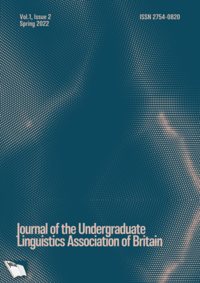Acquisition of Plosive Perception in Korean L2 Learners
Abstract
Korean as an L2 has increased in popularity over the last decade, and with it has opened up a great interest into studying the linguistic nature of Korean L2 acquisition. The goal of this research was to explore the ability of Korean L2 learners to acquire the ability to perceive between Korean stop consonants, in both word-initial and intervocalic positions. Best’s Perceptual Assimilation Model and Flege’s Speech Learning Model are utilised to provide the theoretical framework for discussing naïve listener perception of non- native sound and L2 learner perception of L2 sounds respectively. While English utilises the voiced vs. voiceless contrast, Korean has a three-way distinction between stops. An AX discrimination task was performed amongst 24 participants making up three groups — naïve listeners of Korean, English L1-Korean L2 learners, and Korean L1 speakers. It was hypothesised that the accuracy scores of participants in correctly discriminating between plosives would be lowest in naïve listeners, and highest in native speakers, and that participants would have higher accuracy ratings for the intervocalic tokens as opposed to the word- initial tokens. Surprisingly, the results showed that English L1-Korean L2 learners had the lowest accuracy ratings out of all three groups, as opposed to the prediction that naïve listeners would have the lowest accuracy ratings due to their lack of interaction with Korean phonology. However, there were a number of methodological issues (discussed in the latter Sections of this paper) that may explain the discrepancies between the predicted results and the results attained.

Published
Issue
Volume 1 (Issue 2)DOI
Permalink
- This work is licensed under a Creative Commons Attribution 4.0 International License.
